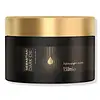What's inside
What's inside
 Key Ingredients
Key Ingredients

 Benefits
Benefits

 Concerns
Concerns

 Ingredients Side-by-side
Ingredients Side-by-side

Water
Skin ConditioningCetearyl Alcohol
EmollientGlycerin
HumectantBehentrimonium Chloride
PreservativeDimethiconol/Silsesquioxane Copolymer
Skin ConditioningIsohexadecane
EmollientDipropylene Glycol
HumectantCocos Nucifera Oil
MaskingHydrolyzed Soy Protein
HumectantSh-Polypeptide-121
Skin ConditioningHydrolyzed Pea Protein
EmollientHydrolyzed Vegetable Protein
Skin ConditioningParfum
MaskingCitric Acid
BufferingLactic Acid
BufferingSodium Benzoate
MaskingSodium Gluconate
Skin ConditioningDisodium EDTA
Sodium Citrate
BufferingCetrimonium Chloride
AntimicrobialBenzyl Salicylate
PerfumingCitronellol
PerfumingHexyl Cinnamal
PerfumingLimonene
PerfumingLinalool
PerfumingCI 19140
Cosmetic ColorantCI 17200
Cosmetic ColorantWater, Cetearyl Alcohol, Glycerin, Behentrimonium Chloride, Dimethiconol/Silsesquioxane Copolymer, Isohexadecane, Dipropylene Glycol, Cocos Nucifera Oil, Hydrolyzed Soy Protein, Sh-Polypeptide-121, Hydrolyzed Pea Protein, Hydrolyzed Vegetable Protein, Parfum, Citric Acid, Lactic Acid, Sodium Benzoate, Sodium Gluconate, Disodium EDTA, Sodium Citrate, Cetrimonium Chloride, Benzyl Salicylate, Citronellol, Hexyl Cinnamal, Limonene, Linalool, CI 19140, CI 17200
Water
Skin ConditioningStearyl Alcohol
EmollientBehentrimonium Chloride
PreservativeCetyl Alcohol
EmollientParfum
MaskingPanthenol
Skin ConditioningIsopropyl Alcohol
SolventBenzyl Alcohol
PerfumingPhenoxyethanol
PreservativePEG-2m
Emulsion StabilisingMethylparaben
PreservativePropylene Glycol
HumectantQuaternium-80
Propylparaben
PreservativeDisodium EDTA
Hexyl Cinnamal
PerfumingCoumarin
PerfumingCitronellol
PerfumingSilica
AbrasiveCitric Acid
BufferingArgania Spinosa Kernel Oil
EmollientSimmondsia Chinensis Seed Oil
EmollientBHT
AntioxidantWater, Stearyl Alcohol, Behentrimonium Chloride, Cetyl Alcohol, Parfum, Panthenol, Isopropyl Alcohol, Benzyl Alcohol, Phenoxyethanol, PEG-2m, Methylparaben, Propylene Glycol, Quaternium-80, Propylparaben, Disodium EDTA, Hexyl Cinnamal, Coumarin, Citronellol, Silica, Citric Acid, Argania Spinosa Kernel Oil, Simmondsia Chinensis Seed Oil, BHT
 Reviews
Reviews

Ingredients Explained
These ingredients are found in both products.
Ingredients higher up in an ingredient list are typically present in a larger amount.
This ingredient is a preservative and often used for it's anti-static properties. You'll most likely see this ingredient in hair conditioners.
It does not cause irritation or sensitization in leave-on products at 1-5%.
Citric Acid is an alpha hydroxy acid (AHA) naturally found in citrus fruits like oranges, lemons, and limes.
Like other AHAs, citric acid can exfoliate skin by breaking down the bonds that hold dead skin cells together. This helps reveal smoother and brighter skin underneath.
However, this exfoliating effect only happens at high concentrations (20%) which can be hard to find in cosmetic products.
Due to this, citric acid is usually included in small amounts as a pH adjuster. This helps keep products slightly more acidic and compatible with skin's natural pH.
In skincare formulas, citric acid can:
While it can provide some skin benefits, research shows lactic acid and glycolic acid are generally more effective and less irritating exfoliants.
Most citric acid used in skincare today is made by fermenting sugars (usually from molasses). This synthetic version is identical to the natural citrus form but easier to stabilize and use in formulations.
Read more about some other popular AHA's here:
Learn more about Citric AcidCitronellol is used to add fragrance/parfum to a product. It is often derived from plants such as roses. In fact, it can be found in many essential oils including geranium, lavender, neroli, and more. The scent of Citronellol is often described as "fresh, grassy, and citrus-like".
Since the Citronellol molecule is already unstable, Citronellol becomes irritating on the skin when exposed to air.
Citronellol is a modified terpene. Terpenes are unsaturated hydrocarbons found in plants. They make up the primary part of essential oils.
Citronellol is not able to be absorbed into deeper layers of the skin. It has low permeability,
Citronellol is also a natural insect repellent.
Learn more about CitronellolDisodium EDTA plays a role in making products more stable by aiding other preservatives.
It is a chelating agent, meaning it neutralizes metal ions that may be found in a product.
Disodium EDTA is a salt of edetic acid and is found to be safe in cosmetic ingredients.
Learn more about Disodium EDTAHexyl Cinnamal is a fragrance ingredient with a similar scent to jasmine. It can be naturally found in chamomile essential oil.
This ingredient is a known EU allergen and may sensitize the skin. The EU requires this ingredient to be listed separately on an ingredients list.
Hexyl Cinnamal is not water soluble but is soluble in oils.
Learn more about Hexyl CinnamalParfum is a catch-all term for an ingredient or more that is used to give a scent to products.
Also called "fragrance", this ingredient can be a blend of hundreds of chemicals or plant oils. This means every product with "fragrance" or "parfum" in the ingredients list is a different mixture.
For instance, Habanolide is a proprietary trade name for a specific aroma chemical. When used as a fragrance ingredient in cosmetics, most aroma chemicals fall under the broad labeling category of “FRAGRANCE” or “PARFUM” according to EU and US regulations.
The term 'parfum' or 'fragrance' is not regulated in many countries. In many cases, it is up to the brand to define this term.
For instance, many brands choose to label themselves as "fragrance-free" because they are not using synthetic fragrances. However, their products may still contain ingredients such as essential oils that are considered a fragrance by INCI standards.
One example is Calendula flower extract. Calendula is an essential oil that still imparts a scent or 'fragrance'.
Depending on the blend, the ingredients in the mixture can cause allergies and sensitivities on the skin. Some ingredients that are known EU allergens include linalool and citronellol.
Parfum can also be used to mask or cover an unpleasant scent.
The bottom line is: not all fragrances/parfum/ingredients are created equally. If you are worried about fragrances, we recommend taking a closer look at an ingredient. And of course, we always recommend speaking with a professional.
Learn more about ParfumWater. It's the most common cosmetic ingredient of all. You'll usually see it at the top of ingredient lists, meaning that it makes up the largest part of the product.
So why is it so popular? Water most often acts as a solvent - this means that it helps dissolve other ingredients into the formulation.
You'll also recognize water as that liquid we all need to stay alive. If you see this, drink a glass of water. Stay hydrated!
Learn more about Water